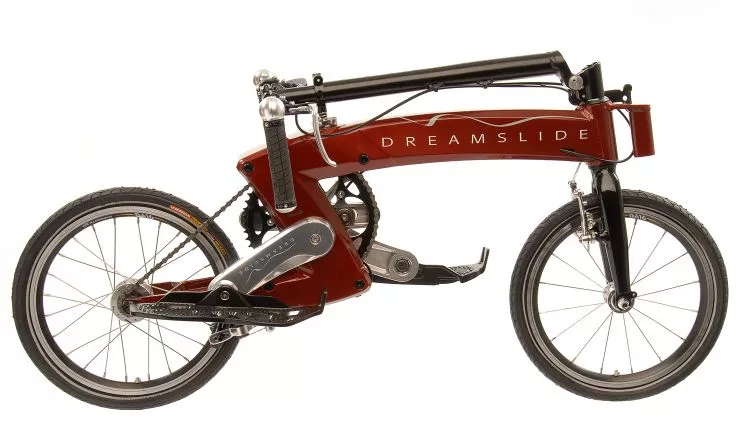Eleven years ago, French rollerblading and boardsports enthusiast Jean‐Marc Gobillard decided that the small wheels of rollerblades weren’t quite speedy enough. He experimented with a few different ideas, which ultimately led him to design the Dreamslide. This unique device combines the standing stance of things like skateboards and roller blades with the efficient locomotion and larger, faster wheels of a bicycle. It even has its own special pedaling system, designed for a standing rider.
The first question people might have is, “Why would you want to stand instead of sit?” Well, for one thing, Gobillard likes the idea of being able to bodily lean into corners like a downhill skier – he believes that by standing on it, the Dreamslide becomes more like a part of the rider’s body, and less like a separate contraption.
Secondly, as anyone who has climbed a hill on a bicycle knows, you can deliver more power to the pedals by standing on them. If you try to ride a bike very far in a standing position, however, you’ll get tired pretty quickly. This is because you have to pump your entire body weight up and down with every pedal stroke. To get around this limitation, Gobillard has invented what he calls the Adaptive Pedaling System, or APS.

On a bicycle, the pedal crank arms are connected by an axle, so they move directly in proportion to one another. With APS, the cranks move independently, adapting to the rider’s muscle power. In the neutral position, both of the rider’s feet are down, one forward and one back. When they start a pedal stroke, the back foot moves forward and lifts slightly, as in a jogging gait, while the front foot slides back.
Not only is this system said to minimize the body-weight-bobbing drawback of pedaling while standing, but it also reportedly eliminates the “dead zone” in the conventional pedaling set up – a point in the pedal revolution at which it has been claimed that neither leg is delivering optimum power to the bicycle. This zone was addressed in the 80s with Shimano’s oval Biopace chainring, the wisdom of which is still debated to this day.

Gobillard asserts that the standing position combined with APS will mean riders can generate more torque with less effort, will have less knee problems, and greater control. If any mechanical engineers out there have an opinion on these claims, we’d love to hear from you.
The Dreamslide is just hitting stores in Europe this year, and is also available through the company website for €1,250 (US$1,682).
Via Popular Science.






